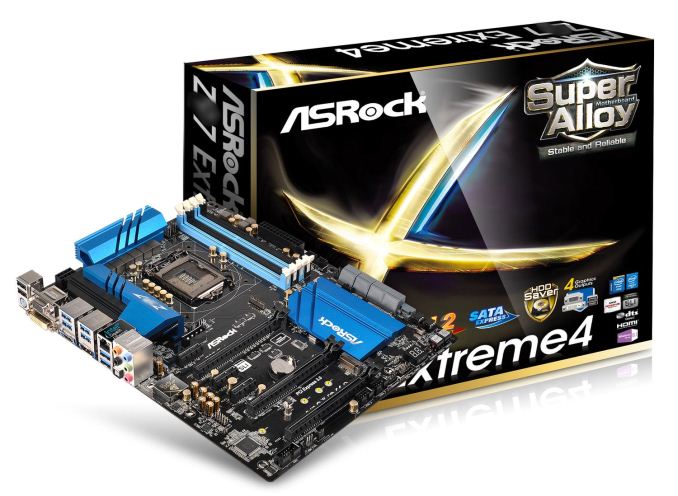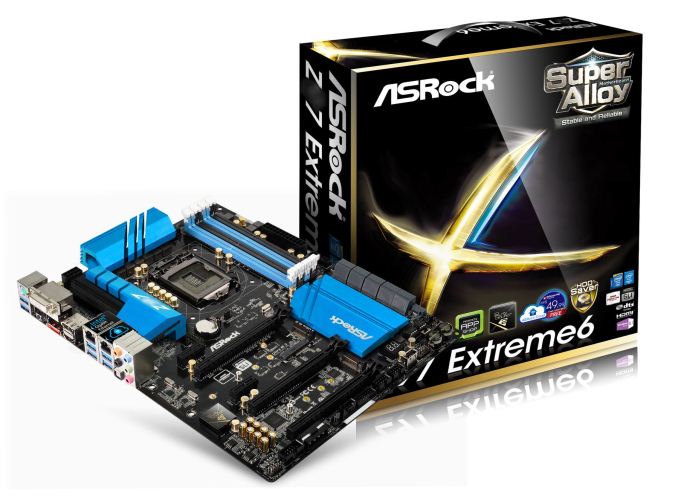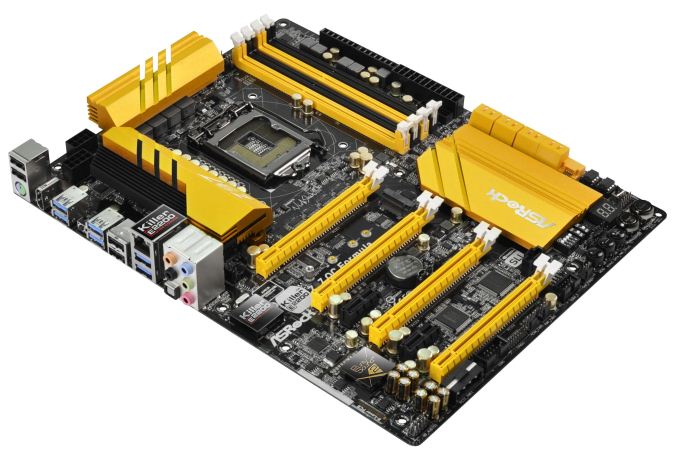Upcoming Intel Based Motherboards from GIGABYTE, ASUS, MSI and ASRock
by Ian Cutress on April 28, 2014 3:30 AM ESTASRock’s New Products
The upcoming range from ASRock uses a striking blend of stand-out colors. Whereas other manufacturers are often seen mixing their colors with black, ASRock is adding an element of vibrancy. Based on the images that we have at our disposal, the mainstream line will start at the Extreme range, move through the Fatal1ty, ITX, and end with the OC Formula at the top.
First up, the Extreme4:
The Extreme4 comes in blue with what looks like 9 SATA ports and an M.2 slot. We see a USB 3.0 header, two removable BIOS chips, a TPM header, ‘Purity Sound 2’ (looks like an upgraded audio package) and Intel Ethernet. I am a little disappointed to see a 4-pin Molex connector in the middle of the board for additional PCIe power though.
Then the Extreme6:
Here are dual Intel NICs, along with what looks like 11 SATA ports, a mini-PCIe slot and two M.2 slots. One of these slots is called ‘Ultra M.2’, with the words ‘PCIe Gen3 x4’ next to it, suggesting that they are implementing an x4 M.2 slot for the faster devices. None of them are actually on the market yet. The Extreme6 has a slightly better positioning for the PCIe power 4-pin molex connector, but I would still prefer a SATA power or 6-pin PCIe.
Moving onto mini-ITX, the ITX/ac:
So while the box says M.2, there is no visible M.2 on the top of the motherboard. Given past experience with ASRock motherboards, they have probably relocated it to the bottom. However on the top they do have a SATA Express port and a mini-PCIe. These are unfortunately just inside the DRAM slots, meaning cables will have to go over large GPUs or memory to be equipped. The WiFi module is a 2T2R 802.11ac solution, and is combined with an Intel NIC. The 8-pin CPU power connector is in the middle of the motherboard, making cable routing a little frustrating.
For gamers, ASRock has the Fatal1ty Killer:
ASRock leaves its Fatal1ty range for features like the Atheros Killer E2200 NIC. The motherboard has four SATA ports, a SATA Express port and an M.2 port. We also get Purity Sound 2 here, which I would guess remains an ALC1150 codec underneath with improved filtering. The motherboard offers a single USB 3.0 header, and the rear IO has the USB gaming port from the previous Fatal1ty motherboard iterations.
Finally at the high end is the OC Formula:
The yellow for the OC Formula has changed slightly, especially on the heatsinks where it is a little more yellow. On the OC Formula ASRock has equipped it with on-the-fly adjustment buttons and voltage check points, along with more power phases. The quad PCIe layout seems devoid of a PLX chip, suggesting an x8/x4/x4 + x4 layout similar to the old Z87 OC Formula. Interesting enough there is a header onboard labeled ‘TB1’ suggesting Thunderbolt support. The motherboard also seems to have Purity Sound 2, a Killer E2200 NIC, an M.2 slot, nine SATA ports, a USB 3.0 header and a 4-pin molex for PCIe power.





















58 Comments
View All Comments
Devo2007 - Monday, April 28, 2014 - link
I know at least one enthusiast site already posted a review of a Z97 board today; a site that, AFAIK has usually adhered to NDAs.Devo2007 - Monday, April 28, 2014 - link
.. Actually, one of the boards shown here (and with non-blurry photos to boot).That said, if the NDA is still in place, kudos to Anandtech for not breaking them. You guys don't need to be "first" to post reviews and such as the quality of content makes any wait worth it.
Flunk - Monday, April 28, 2014 - link
I wholeheartedly agree there, best is much better than first and Anandtech is one of the only top-tier tech sites in my eyes.Antronman - Monday, April 28, 2014 - link
As per the usual, Asus will leave the competition in the dust and be the only choice for a serious build.jimjamjamie - Monday, April 28, 2014 - link
Are they really that much better than say Gigabyte? What makes them better? Genuinely interested as I'm using a G1.Sniper just now and I don't think I have any complaints.willis936 - Monday, April 28, 2014 - link
Their marketing is clearly better. The only reason I went asus on my last build is because the number of fan headers and bios fan voltage control was better than what I found on other boards of the same price. In most cases you'll get what you pay for and just make sure the boxes you want checked are checked (decent audio codec, PCIe requirements, outward facing port requirements, etc.) In the gaming/overclocking market there isn't much variation between products in terms of meaningful stability/overclocking features. The power circuitry has become much less important in recent years because they're all much better than they used to be. The biggest factor is the silicon lottery with your CPU/GPU nowadays.Antronman - Monday, April 28, 2014 - link
Power circuitry still does matter.A couple hundred MHz can mean the difference between a world record or "getting close".
Higher rated caps and VRMs, means more stable and better power delivery.
Fuse protections means any sudden jump in voltage or power problem means that your product won't be reduced to a piece of silicon with a bit of metal.
LN2 mode buttons means more precise OCing for new OCers.
Super stable BIOS.
That's not just the boards, but the GPUs as well.
All that's missing is a good chip.
willis936 - Monday, April 28, 2014 - link
Certainly but people looking to drop a few grand on LN2 aren't people looking to make a stable daily build. If you want more performance on a computer you'll be booting and running daily the chip variation matters a lot more than component quality. I just have a hard time trusting anything I can safely say is more marketing than engineering. A good daily OC will see little difference between a $150 board and a $400 board. What really changes is the storage and peripheral interface features.Antronman - Monday, April 28, 2014 - link
But it will.Less voltage means it is a better OC.
With RoG, you can consistently use less voltage to OC your chip.
RoG has a superior interface, and also way more WC support.
Just about every major watercooling product maker (e.g. EKWB, XSPC, Aquacomputer) has mobo blocks for almost every RoG board.
willis936 - Monday, April 28, 2014 - link
You'll only be using less voltage on better chips.